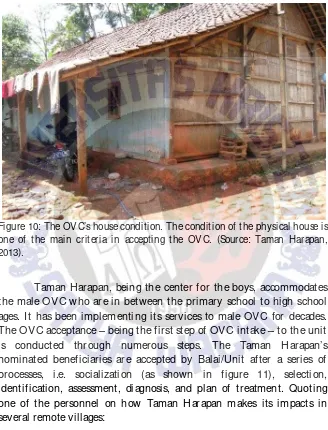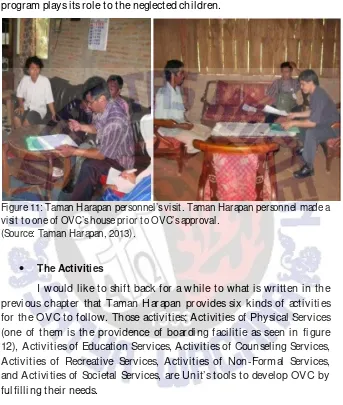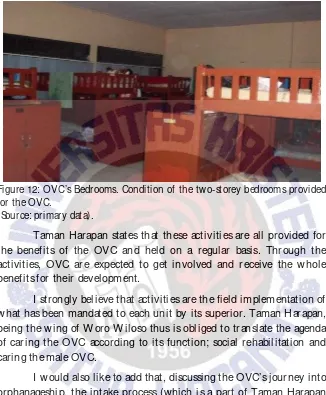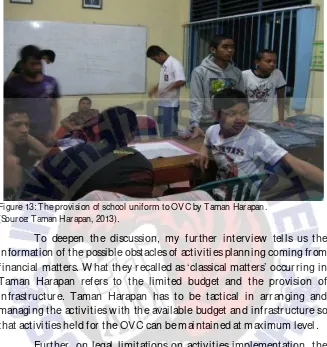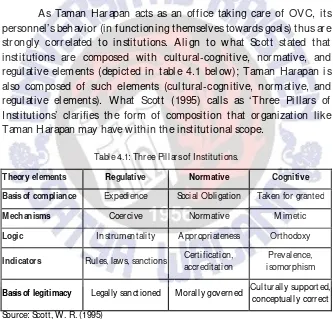63
The Activities
I ntroduction
Attached to what has been written in Chapter Three, I would like to share my interview results from the personnel of Unit Rehabilitasi Sosial Taman Harapan. This chapter mainly discusses the activities, its establishment and process, implementation, and also evaluation from Taman Harapan’s view. Through this chapter, we can also get additional information from Unit Rehsos Taman Harapan personnel, which may be supporting the ideas of the activities held in Taman Harapan.
Research Results
H ow OV C entered Taman H arapan
64
‘OVC come into orphanage as a result of their disadvantage-ness…which is resulted from (their) socio-economic (condition) and parental backgrounds…’
Figure 10: The OVC’s house condition. The condition of the physical house is one of the main criteria in accepting the OVC. (Source: Taman Harapan, 2013).
Taman Harapan, being the center for the boys, accommodates the male OVC who are in between the primary school to high school ages. It has been implementing its services to male OVC for decades. The OVC acceptance – being the first step of OVC intake – to the unit is conducted through numerous steps. The Taman Harapan’s nominated beneficiaries are accepted by Balai/Unit after a series of processes, i.e. socialization (as shown in figure 11), selection, identification, assessment, diagnosis, and plan of treatment. Quoting one of the personnel on how Taman Harapan makes its impacts in several remote villages:
65
This process leads to the approval of the OVC. The OVC, in this case, is the target of service implementation in which Balai’s/Unit’s program plays its role to the neglected children.
Figure 11: Taman Harapan personnel’s visit. Taman Harapan personnel made a visit to one of OVC’s house prior to OVC’s approval.
(Source: Taman Harapan, 2013).
The Activities
66
Figure 12: OVC’s Bedrooms. Condition of the two-storey bedrooms provided for the OVC.
(Source: primary data).
Taman Harapan states that these activities are all provided for the benefits of the OVC and held on a regular basis. Through the activities, OVC are expected to get involved and receive the whole benefits for their development.
I strongly believe that activities are the field implementation of what has been mandated to each unit by its superior. Taman Harapan, being the wing of W oro W iloso thus is obliged to translate the agenda of caring the OVC according to its function; social rehabilitation and caring the male OVC.
67 ‘The diagnosis of the family (condition) is conducted… (to identify) their backgrounds, on their disabilities or (other condition:) broken home’.
The next step is identification, which is scheduled on M ay, followed by assessment conducted in the same month. The final step is the plan of treatment, which implemented based on the OVC’s academic/formal education classification.
The next in my interview was the origin of the activities establishment. I was completely surprised by the facts that the activities are more complex when viewed from inside (Taman Harapan). The activities themselves are the products of Taman Harapan as a unit. The unit is entitled to design and modify the activities, subject to the OVC’s interests, as quoted from the personnel that:
‘Specifically, these activities are designed by Taman Harapan’.
Related to this, I was given a thorough explanation that the allocated fund has been prepared for every unit as Taman Harapan, with a fix amount, based on its annual budget. The funding, however, does not demand any specific activity to be performed in the unit. Despite the flexibility, the unit is obliged to fulfill its function with a maximum impact. The unit, therefore, has any right to create the activities, according to its needs. These activities will need to be fit for implementation and that is achieved after the approval from all parties. Once confirmed, Balai plays its role to approve the whole agenda for OVC.
68
‘Children are involved in the planning according to their talents and interests.’
From the statement, I would like to emphasize based on its logical thinking that it is important to have the information regarding their enthusiasm, especially when linked to the formulation of the activities. Our interview clarifies that the data received from the OVC will subsequently be used as the base of the activity design. On this, Taman Harapan confirms that the involvement of the OVC is always present. The OVC’s voice is heard through the sharing and discussion between the OVC, personnel/staffs/carers, organized by the Taman Harapan and W oro W iloso. The discussion spawns the new form of information regarding the possible activities that will be held for the OVC.
Taman Harapan, in this discussion, also understands and realizes the diversity of the OVC’s potential abilities. These kinds of abilities deserve further treatments, trainings, and maintenance in a form of activity. The discussion of the diversity of the OVC’s potential abilities leads us then to the appropriateness of the related activities which are created to accommodate their talents. W hen interviewed whether these activities are formulated in accordance to OVC’s potential abilities and diversities, Taman Harapan’s personnel declared that the activities have been implemented accordingly.
The Limitations on Activities
69
needs to be very careful in budgeting, especially when dealing with the outcomes. On this, Taman Harapan asserts that:
‘W ith the minimum budget that we received we need to harness it to maximum results’.
Despite the designing has taken place, the implementation itself sometimes can be more difficult than expected. W hat I found in the field is that the implementation indicates that it does not flow to the fullness of the planned activities, which ends to the disfullness of what the OVC receive. On the limitations, Taman Harapan confirms that they are present and is influencing the activities as what quoted below:
‘There are limitations (in Taman Harapan)…there is obviously financial limitations in activities…legal (limitations) and consensus limitations so that we cannot freely implement the activities such as the involvements of third parties’
Coming to another discussion of understanding the activities duration, it is necessary to shift back to the previous discussion of the approval of the activities. The activities implemented in Taman Harapan are based on annual plan, which also means that it is going to be evaluated annually (based on school’s academic year) as asserted by one of the personnel that:
‘These activities are evaluated annually… based on the academic calendar.’
70
Figure 13: The provision of school uniform to OVC by Taman Harapan. (Source: Taman Harapan, 2013).
To deepen the discussion, my further interview tells us the information of the possible obstacles of activities planning coming from financial matters. W hat they recalled as ‘classical matters’ occurring in Taman Harapan refers to the limited budget and the provision of infrastructure. Taman Harapan has to be tactical in arranging and managing the activities with the available budget and infrastructure so that activities held for the OVC can be maintained at maximum level.
Further, on legal limitations on activities implementation, the personnel give us an explanation that this matter has a flexible nature. The legal regulations had been made for them as criterion that will guide them to activities design and implementation. As far as all aspects are in sync to the stipulated regulations, personnel have the flexibility to design the type of activities. This happens in Taman Harapan.
71
activities which are conducted aligned to what has been stipulated by system (Balai and Unit) are welcome to implementation. The other way around, any activity opposing Balai’s/Unit’s system or value will be rejected to implementation. One of the examples is Taman Harapan’s response on how certain activity (Activities of Counselling Services; Skill) might affect OVC’s state of learning and developing. Years earlier, the skill training introduced by third party to OVC had given heavy pressure to OVC. The activity had absorbed the OVC into the third party’s business system in where they had to deal with targets and other demands. Taman Harapan saw that the activity had put a lot of burden to children. The management, subsequently, took immediate action to keep the OVC on track by re-evaluating the activity. Following the incident, Taman Harapan decided not to employ that kind of activities and alike into its agenda. This gives a little bit of description on how the concensus limitations work in the unit.
The Activities I ndicators
I was suddenly reintroduced to the expected state of the activities’ objectives. I then followed up with the interviews and observations on signs of indications in where successes are attainable as what my research indicates. In the indicators of OVC’s successfulness in each activity, Taman Harapan stated that OVC successfulness is determined by the change of attitudes and actions. The changes are reflected on the changes of personality; such as the introvert to extrovert, pessimistic to optimistic. Another example comes from the OVC’s social life, not only that they have to be in one unity as a group of persons/individuals under the same roof, but more than that, their care to friends is also a possible indicator. This indicator also gives us a perspective that OVC are demanded to be more in taking an initiative and proactive actions in everything they do, especially on the academic performance as spoken by Taman Harapan personnel that:
72
Additionally, all of the OVC are given the privilege to join all activities, without any exception. According to Taman Harapan personnel, the OVC’s discretions to get involved with one/few/many/all activities are at their own choice, respecting their focus on the academic schedules and processes, as what is quoted from one of the personnel:
‘OVC can follow all activities… as long as they do not disturb their academic study.’
Completing this topic, one thing that needs to be attached to the discussion is the indicators of the activities targets. M y research shows us that OVC, once again, get involved into the activities without any goals towards real or tangible targets. The main principle does not refer to the physical results, but to their changes of attitudes and actions. The value of these activities is to create the willingness to abilities, independently.
M ore about Activities
The following discussions are more about activities produced as complementary parts supporting the provision of activities in Taman harapan. The fact that OVC are the beneficiary of all activities implementation, the purpose of these activities is, therefore, to help OVC to help themselves. As I try to breakdown all of the activities in Taman Harapan, the OVC are then expected to: live a good healthy life, improve the academic performances, have the positive change of mental, social, and religious behavior, absorb the support for their academic performance, and to have a good social life with society. The activities are implemented and organized by social workers and instructors in cooperation with structural officers and carers. Additionally, small meeting is held occasionally, involving OVC and the carers to organize all forms of activities to their availability.
73
from top (the head of Balai Rehsos W oro W iloso) to down (the carers), according to SOP (Standard Operating Procedure). The authorized officer is responsible at any stage in his/her assigned field. Additionally, beside the mentioned steps, the staffs also supervise the activities implementation by making observations on materials, OVC, responses and other possible feedbacks.
As a follow through, the activities are evaluated by the assigned staffs. The observation on the academic results and other indicators will be the main material for the evaluation. Apart from that, routine meetings are held periodically (every three months/semester), either in forms of unit meeting or joint meeting.
The evaluation does not stop at that point as it is also conducted to whole personnel of Taman Harapan. By the end of the year, every personnel receives an evaluation through what is called DP3 (Daftar Penilaian Pelaksanaan Pekerjaan). This evaluation is based on the SOP and is managed by the supervisor at every stage of structural function. This is held to confirm the smooth process of any activities services, for the benefits of the OVC.
The OVC and Achievements
74
To follow up these kinds of achievements, Taman Harapan has made a more specific cooperation with the associated school and also instructors (the instructors involved in the activities of non-formal activities) to enhance OVC’s potential talents. Taman Harapan says that follow up should be made upon the demand of OVC’s interests, so in as another option, that they might be provided with the possibility of entrepreneurships.
Additionally, the instructors, being the third party in the certain activities (eg. the activities of non-formal services), play a role in developing the OVC towards their goals. The evaluation is not made to them, respecting their goodwill to assist OVC. This statement is supported by Taman Harapan’s consideration in accepting the instructors based on the competencies and trusts. Taman Harapan, however, has always made coordination with the instructors in regards to the implemented activities.
Analysis
I nstitutional Analysis
To understand the activities from the perspective of organization, I would like to propose that in planning, designing, and implementing activities, Taman Harapan is not detached from social elements inside the activities’ makers and doers. Apart from its standing as an organization, Taman Harapan is a structure of people with social movements happening inside it.
75 ”Institutions are social structures that have attained a high degree of resilience. They are composed of cultural-cognitive, normative, and regulative elements that, together with associated activities and resources, provide stability and meaning to social life. Institutions are transmitted by various types of carriers, including symbolic systems, relational systems, routines, and artifacts. Institutions operate at different levels of jurisdiction, from the world system to localized interpersonal relationships. Institutions by definition connote stability but are subject to change processes, both incremental and discontinuous”.
As Taman Harapan acts as an office taking care of OVC, its personnel’s behavior (in functioning themselves towards goals) thus are strongly correlated to institutions. Align to what Scott stated that institutions are composed with cultural-cognitive, normative, and regulative elements (depicted in table 4.1 below); Taman Harapan is also composed of such elements (cultural-cognitive, normative, and regulative elements). W hat Scott (1995) calls as ‘Three Pillars of Institutions’ clarifies the form of composition that organization like Taman Harapan may have within the institutional scope.
Table 4.1: Three Pillars of Institutions.
Theory elements Regulative Normative Cognitive
Basis of compliance Expedience Social Obligation Taken for granted
M echanisms Coercive Normative Mimetic
Logic Instrumentality Appropriateness Orthodoxy
Indicators Rules, laws, sanctions Certification,
accreditation
Prevalence, isomorphism
Basis of legitimacy Legally sanctioned Morally governed Culturally supported, conceptually correct
Source: Scott, W. R. (1995)
76
the implementation of its straight line attempts of its goal pursuance), provide the organization stability and meaning to social life to personnel inside the system. Operated with rules and guidance, Taman Harapan is subjected to change processes, at every level of its structural implementation.
In explaining further the understanding of the social structures, I would like to imply Fredrik Bjorck’s (2004) thought into this discussion. The social structures are both imposed on and upheld by the actors (i.e. individual/s inside Taman Harapan, or organization, i.e. Taman Harapan itself). The rationale of institution-behaving is described through the narrative passage quoted from Bjorck (2004) below.
One cognitively oriented view is that a given institution is encoded into an actor through a socialization process. W hen internalized, it transforms to a script (patterned behavior). W hen (or if) the actor behaves according to the script, the institution is enacted. In this manner, institutions are continuously (re-)produced. The enactment of an institution externalizes or objectifies it - other actors can see that the institution is in play, and a new round of socialization starts. After some time, the institution (and the resulting patterned behaviour) becomes sedimented and taken for-granted. Then, it might be difficult for the actors even to realize that their behaviour is in fact partly controlled by an institution. Acting in accordance with the institution is viewed as rational by those who share the institution.
The passage strongly tells us the involvement of individuals inside the organization and the way they absorb the institutions. The process itself hardly gives us the obvious agenda in dealing with organization’s mission but as we reflect to its surroundings it is becoming real and unavoidable. Also to be noted is the role individual, as I might say personnel inside the organization. Through them – individual/group – the institutions are introduced and reintroduced.
77
Institutions, Population and Environmental Change –, 2005), as quoted below:
Institutional analysis is that part of the social sciences which studies how institutions—i.e., structures and mechanisms of social order and cooperation governing the behavior of two or more individuals—behave and function according to both empirical rules (informal rules-in-use and norms) and also theoretical rules (formal rules and law). This field deals with how individuals and groups construct institutions, how institutions function in practice, and the effects of institutions on society.
Since my research is conducted within the scope of Taman Harapan, I would then also like to emphasize that the individuals in Taman Harapan (personnel) are taking parts in every possible involvements. The personnel thus are the carriers of institutions in which our discussion lies. As Taman Harapan is led by personnel, the relation between personnel emerges. Years through years (with periodic changes and rotations on certain structural positions), personnel are getting accustomed to what they do.
78
The I nstitutions inside Taman H arapan
To bring us all to the more detailed institutions, I would like to share the three institutions inside Taman Harapan, namely:
Authoritative
Taman Harapan is structurally under W oro W iloso. The personnel working in both offices are engaged in some structural relation, when necessary. Taman Harapan in its daily operation has its own pattern in its operational implementation though supervised by W oro W iloso. The supervisions are held periodically or when necessary. The way leadership plays its role in government office such as Taman Harapan is clear. The environments (institutions) brought by personnel will then bring something out to an environment-adjusted leadership.
79
to deal with regulative rules (the completeness of activities elements, inclusively the instructorship). Additionally, in such condition, bureaucracy limitation is factor that should be also considered.
Unanalytical Evaluation (Taken for Granted)
Another form of institution is found in the personnel in dealing with their activities environment. My research indicates that the propensity to make unanalytical evaluation is found in personnel. Personnel’s responses in dealing with certain matters seem to be an escape to justify what they are doing is right, but when observed thoroughly, not precisely in accordance to what Taman Harapan should do. One example is the termination of the certain activity was ever made due to the OVC’s time availability and third party’s business pressure (as previously discussed in Chapter Three). Those reasons, in my opinion, derail OVC from entrepreneurships, being both alternative and main potency for OVC to develop themselves. I think, through time management, communication, and balance system, the activity might achieve better results without even terminating it.
80
Formal-Education Oriented Institution
Despite its goal (i.e ‘to help OVC to help themselves’), Taman Harapan, as my research strongly indicates, is run as a formal education-based ‘orphanage’. The pressure of formal-education value is huge. That can be explained through numerous activities dedicated mainly to the successfulness of formal academic performances. Based on that, in my opinion, formal education reroutes Taman Harapan’s course from its main course. Regulatively, Taman Harapan is the place of OVC empowerment as a whole. The empowerment cannot mean formal education. Empowerment has all-round nature which is subjected to OVC’s talents and potential abilities. That will result in a condition where all OVC are accommodated in its maximum capacity. The formal-academic conformity is made for the purpose of both intrinsic and extrinsic successfulness of Taman Harapan. As finding abstract way is too difficult to measure, Taman Harapan uses formal-education as tool to measure itself; which can be beneficial or detrimental. The reason behind it, according to my interpretation, is the basic education compulsory which has been well internalized into the middle of society and gradually become the societal norm.
Conclusion
